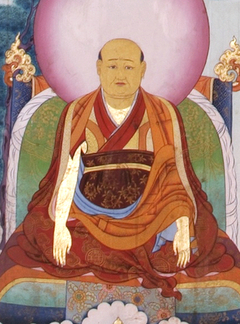Prologue to Treasury of Precious Qualities
Mirror of the Mind
Prologue to The Treasury of Precious Qualities
by Patrul Rinpoche
Here, there are three points which need to be explained in order to make students suitable recipients for the teaching: 1) the greatness of the author, the master, 2) the greatness of the composition, and 3) the way to impart and listen to a teaching that has such qualities.
1. The Greatness of the Author, the Master
The author of this treatise is the Great Perfection adept Rangjung Dorje, the Vidyādhara Jigme Lingpa. He had an excellent grasp of, and great devotion for, the teachings of the Bliss-Gone One (sugata). Although he did not strive to develop the intellectual knowledge born of study and contemplation, still, through the force of directly seeing the nature of ultimate reality, the natural state of the Great Perfection, which is the wisdom that understands the nature of things, he gained the wisdom born of meditation that comprehends all things in their multiplicity, and thus came to master the insight that precisely discerns phenomena. In addition, he wore the armour of working for the benefit of himself and others with great compassion during post-meditation.
2. The Greatness of the Composition
The Dharma teaching that concerns us here is the treatise called The Treasury of Precious Qualities, which contains the pith instructions of limitless vehicles, including the Great Vehicle.
3. The Way to Impart and Listen to a Teaching That Has Such Qualities
This is explained through five major structural themes.
1.The Purpose
The Treasury of Precious Qualities has thirteen chapters and is intended for fortunate individuals who can easily realize and comprehend its meaning by listening, contemplating and meditating. It is a sacred, skilful means for accomplishing the two aims, temporary and ultimate. That is its purpose.
2. The Summarised Meaning
The text consists of three parts: the causes of setting out on the path, the path itself, and the ultimate fruition.
3. The Meaning of the Words
This is explained when the text is taught in an elaborate manner.
4. Showing How All the Chapters Are Connected
The first chapter explains the reasons why the freedoms and advantages are difficult to obtain, and this functions as a cause for entering the Dharma.
The second chapter explains that such freedoms and advantages are by nature impermanent. This serves as an encouragement to enter the Dharma swiftly and with diligence rather than procrastinating and leaving it for another time.
The third chapter explains what to abandon and what to adopt concerning actions and their results, given that in addition to things being impermanent, our next life is determined exclusively by good and bad actions.
The fourth chapter teaches the suffering of saṃsāra, since the results of positive and negative actions are the realms of the six classes.
Once the suffering of saṃsāra is understood, the fifth chapter then explains the skilful means to eliminate that, namely the group of the 'four great wheels' that provide an entrance to the Dharma.[1]
For someone who possesses these four great wheels in their entirety, the sixth chapter teaches taking refuge, since this is the foundation and support for entering the teachings.
The seventh chapter then teaches the four immeasurables, which, after taking refuge, mark the initial entrypoint to the Great Vehicle.
The eighth chapter teaches the actual generation of the mind set upon awakening (bodhicitta), since training the mind in the four immeasurables automatically causes bodhicitta to arise and makes the mind pliable.
The ninth chapter then teaches the precepts of bodhicitta in aspiration and action, since it is necessary, once bodhicitta is aroused, to train correctly in its precepts and thereby maintain it without fail.
Someone who has generated bodhicitta in this way will naturally become magnanimous and a suitable vessel for the profound Dharma. It is appropriate for such an individual to enter the path of the Vajra Vehicle of Secret Mantra, since it is a blissful and swift path. Thus, in order to explain this further, the tenth chapter teaches the general nature of the Secret Mantra Vehicle and the eleventh and twelfth chapters thoroughly describe the ground and path of the Great Perfection and fully demonstrate how they constitute an excellent way for those of sharper faculties to gain liberation within a single lifetime. The thirteenth chapter then thoroughly reveals the ultimate fruition that comes from bringing the path to completion in this way.
5. Explanation Through Responses to Objections
When this text is explained elaborately any possible arguments from opponents will be thoroughly eliminated through logical analysis based on scripture and reasoning and everything will thus be made clear.
This was spoken by Patrul.
| Translated by Han Kop with the kind assistance of Khenpo Sonam Tsewang, 2021.
Bibliography
Tibetan Edition
o rgyan 'jigs med chos kyi dbang po. "yon tan rin po che'i mdzod kyi 'chad thabs yid kyi me long." In gsung 'bum/ o rgyan 'jigs med chos kyi dbang po. BDRC W1PD107142. 2: 439–442. khreng tu'u: si khron dpe skrun tshogs pa/ si khron mi rigs dpe skrun khang, 2009.
Secondary Sources
Jigme Lingpa & Kangyur Rinpoche. 2013. Treasury of Precious Qualities: Book Two: Vajrayana and the Great Perfection. Translated by Padmakara Translation Group. Boulder, CO: Shambhala.
Kangyur Rinpoche. 2001. Treasury of Precious Qualities. Translated by Padmakara Translation Group. Boston and London: Shambhala.
Version: 1.1-20210920
-
The four great wheels, which Nāgārjuna refers to in his Letter to a Friend (Suhṛllekha), are: 1) to live in solitude, 2) to follow a spiritual teacher, 3) to cultivate the highest aspirations, and 4) to gather a great store of merit. ↩
